Key Trends in Customer Experience Journeys for 2025

The way businesses approach customer experience journeys is undergoing a significant transformation. By 2025, 89% of businesses are expected to compete primarily on customer experience, surpassing traditional factors like product or price. This shift reflects a growing demand for personalized, seamless interactions that meet rising consumer expectations. For instance, 64% of consumers believe AI will improve the speed and quality of customer service within the next few years. Companies like Sobot are already leading this evolution, offering AI-driven solutions that empower businesses to stay ahead in this dynamic landscape.
AI-Driven Personalization in Customer Experience Journeys
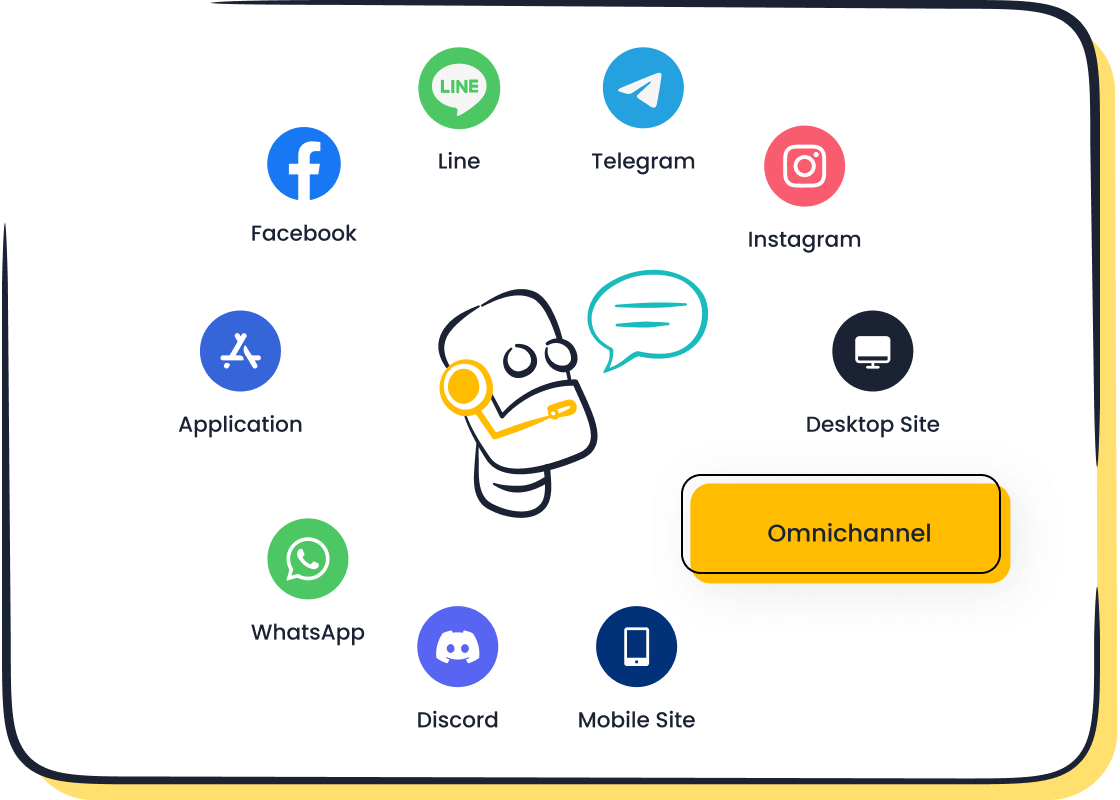
Defining AI-driven personalization and its role in CX
AI-driven personalization tailors every interaction to meet your unique needs. It uses advanced algorithms to analyze data, predict preferences, and deliver relevant recommendations. This approach ensures that you receive content, products, or services that align with your expectations. For businesses, personalization enhances customer experience by creating seamless and intuitive journeys. It also builds trust and loyalty, encouraging repeat interactions.
A study highlights how AI-driven personalization improves customer engagement. Personalized recommendations increase relevance, while targeted campaigns boost conversion rates. The table below summarizes the benefits:
| Benefit Type | Description |
|---|---|
| Enhanced Customer Experience | Personalized recommendations ensure customers see content that is most relevant to them. |
| AI-driven personalization creates a seamless and intuitive user journey. | |
| Increased Customer Loyalty | Consistently relevant recommendations build trust, encouraging repeat interactions. |
| Personalized experiences make customers feel valued, increasing loyalty. | |
| Higher Engagement Rates | AI allows for highly targeted marketing campaigns, leading to higher engagement and conversion. |
| Businesses can see significant ROI from personalization efforts. |
How Sobot's Chatbot enhances digital customer experience with AI
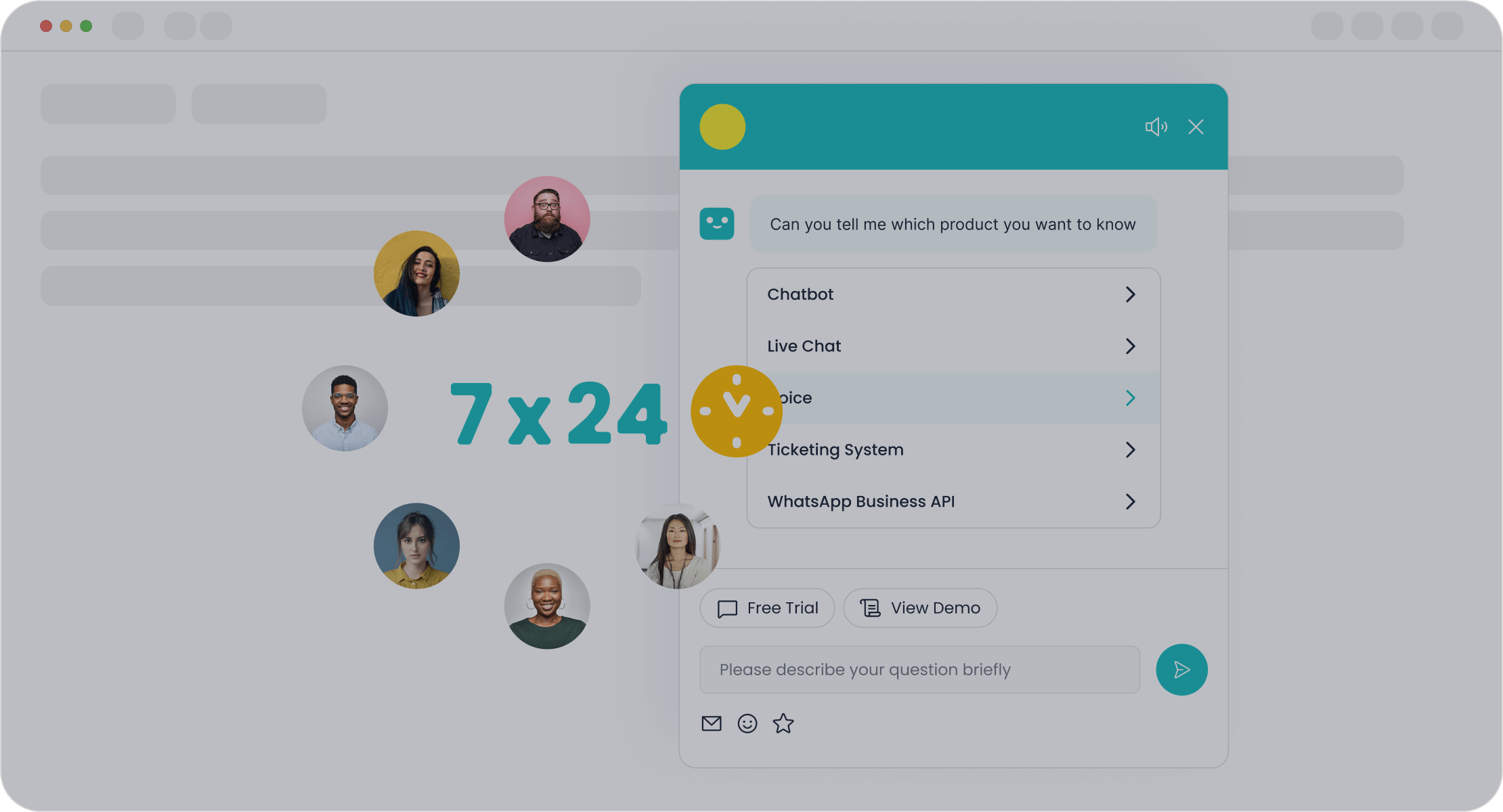
Sobot's AI Chatbot revolutionizes digital customer experience by automating interactions and providing instant, accurate responses. It operates 24/7, ensuring your queries are resolved anytime. Its multilingual capabilities allow seamless communication in your preferred language. The chatbot also uses a knowledge base to deliver intelligent replies, enhancing efficiency and cutting costs.
Performance metrics demonstrate its impact:
| Metric | Value |
|---|---|
| Correct Answers Rate | Over 80% |
| Customer Satisfaction Score | Over 95% |
| Self-Service Question Resolution | 22.2% |
| Problem Resolution Rate | 85% |
| Positive Feedback Rate | 96%+ |
These results highlight how Sobot's Chatbot improves customer satisfaction and operational efficiency. By integrating AI, businesses can deliver personalized experiences that drive loyalty and engagement.
Real-world examples of AI transforming customer interactions
AI has redefined how businesses interact with customers. Companies now use AI to provide personalized experiences, tailor marketing campaigns, and enhance support services. For example:
- AI-powered chatbots handle inquiries 24/7, reducing wait times and improving satisfaction.
- Retailers use AI to recommend products based on browsing history, increasing sales.
- Businesses leverage AI insights to optimize operations and identify customer needs.
Samsung's collaboration with Sobot showcases this transformation. By implementing Sobot's all-in-one contact center solution, Samsung unified its communication channels and improved data connectivity. This integration led to a 30% increase in agent efficiency and a 97% customer satisfaction rate. Such examples demonstrate how AI-driven personalization elevates customer experience and fosters loyalty.
Predictions for AI's impact on customer experience in 2025
AI is set to revolutionize customer experience by 2025, reshaping how businesses interact with their audiences. Nearly half of technology leaders report that AI is now fully integrated into their companies' core strategies. This trend highlights the growing reliance on AI to enhance customer interactions and streamline operations. By embedding AI into products and services, companies can expect productivity gains of up to 30%, faster time-to-market, and increased revenue.
In the banking sector, AI will play a critical role in addressing challenges like declining customer satisfaction and profitability. Innovative solutions, such as AI-powered chatbots and predictive analytics, will help banks deliver personalized experiences while improving operational efficiency. For example, Sobot's AI Chatbot already demonstrates how automation can resolve customer queries instantly, ensuring seamless interactions across multiple channels.
AI's ability to analyze vast amounts of data will also enable businesses to predict customer needs more accurately. Retailers, for instance, can use AI to recommend products based on browsing history, creating tailored shopping experiences. This level of personalization fosters loyalty and encourages repeat purchases. Furthermore, AI-driven insights will allow companies to identify gaps in their service offerings, ensuring continuous improvement.
By 2025, AI will not only enhance customer interactions but also redefine the standards of service excellence. Businesses that embrace AI will gain a competitive edge, delivering faster, smarter, and more personalized experiences. As a result, you can expect a future where every interaction feels intuitive and tailored to your needs.
Seamless Omnichannel Integration for Digital Customer Experience
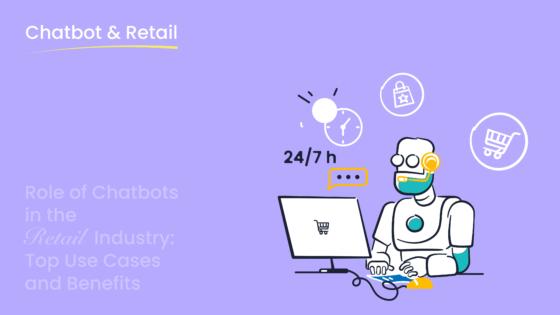
What is omnichannel integration, and why does it matter?
Omnichannel integration connects all customer touchpoints into a unified system, ensuring a seamless experience across channels. Whether you interact with a brand through a website, mobile app, or physical store, omnichannel integration ensures consistency. This approach matters because it meets modern customer expectations for convenience and flexibility.
According to industry expert Gleason, omnichannel retail creates a strategic advantage by blending physical and digital experiences. For example, you can research a product online and purchase it in-store without any disruption. This consistency fosters trust and loyalty. A study also shows that 66% of customers prefer choosing their journey through a brand’s channels, while 16% are willing to pay more for a great experience.
Omnichannel integration is no longer optional. It has become essential for businesses aiming to deliver a superior customer experience and build long-term relationships.
Sobot's solutions for creating unified customer experience journeys
Sobot offers advanced tools to help businesses achieve seamless omnichannel integration. Its all-in-one contact center solution unifies communication channels like chat, email, voice, and social media. This allows you to interact with brands effortlessly, regardless of the platform you choose.
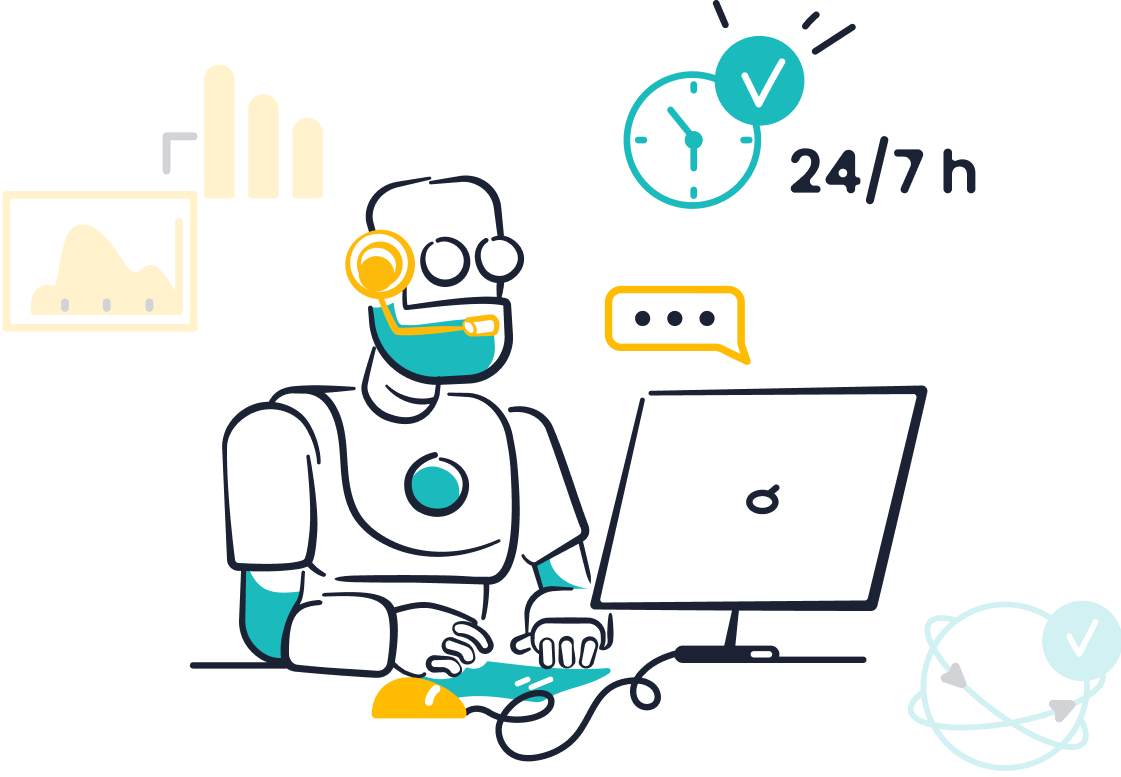
For example, Sobot’s AI Chatbot operates across multiple channels, providing instant responses and personalized support. It integrates with internal systems like ERP and ticketing, ensuring agents have access to complete customer histories. This eliminates repetitive interactions and enhances efficiency. Samsung, a global leader in technology, used Sobot’s solution to unify its channels, achieving a 97% customer satisfaction rate and a 30% boost in agent efficiency.
By leveraging Sobot’s solutions, businesses can create consistent, reliable, and personalized customer journeys that drive satisfaction and loyalty.
Overcoming challenges in achieving seamless omnichannel CX
Implementing an omnichannel experience comes with challenges. Businesses often face issues like siloed channel management, logistics inefficiencies, and technology barriers. For example, conflicts between departments over customer databases can disrupt integration efforts.
To overcome these challenges, companies need to adopt the right strategies. Resolving siloed management requires breaking down barriers between teams and fostering collaboration. Technology barriers can be addressed by selecting integration tools like Sobot’s platform, which simplifies the process. Additionally, focusing on skill development and cultural shifts within the organization ensures a smoother transition.
Proactively addressing these obstacles enables businesses to deliver a seamless omnichannel experience. This not only improves customer satisfaction but also enhances operational efficiency and brand loyalty.
Future trends in omnichannel strategies for 2025
Omnichannel strategies are evolving rapidly, and 2025 will bring exciting advancements that redefine how you interact with brands. Businesses are focusing on creating seamless customer journeys that meet your expectations across every platform. Here are the key trends shaping the future of omnichannel strategies:
- Personalization: Brands will use customer data to tailor every interaction. Personalized experiences will increase engagement and drive higher conversion rates. For example, Sobot’s AI Chatbot already delivers customized support by analyzing your preferences and providing instant replies.
- Rise of Voice Search: AI-powered voice assistants will make shopping hands-free. You’ll be able to search for products or services using voice commands, simplifying your experience.
- Social Commerce: Social media platforms will integrate shopping features, allowing you to discover and purchase products without leaving the app. This trend will make your shopping journey more convenient and engaging.
- Mobile Marketing: With smartphones dominating your daily life, businesses will adopt mobile-first strategies. You’ll see more mobile-friendly websites, apps, and campaigns designed to enhance your experience on the go.
These trends highlight the growing importance of omnichannel strategies in delivering exceptional customer experiences. Sobot’s solutions, such as its unified contact center platform, are already paving the way for businesses to adapt to these changes. By integrating communication channels like chat, email, and social media, Sobot ensures you receive consistent and personalized support, no matter where you connect.
As these trends unfold, you can expect brands to prioritize your convenience and satisfaction. Businesses that embrace these strategies will not only meet your expectations but also build lasting relationships with you.
Proactive Engagement: Anticipating Customer Needs
The importance of proactive customer engagement in 2025
Proactive customer engagement will redefine how businesses interact with you by 2025. Instead of waiting for you to reach out, companies will anticipate your needs and address them before they become issues. This approach enhances your experience by reducing effort and creating seamless interactions.
Here’s why proactive engagement matters:
- It ensures personalized experiences by predicting your preferences and offering timely solutions.
- You’ll receive reminders about appointments or payments, making your life easier.
- By 2025, proactive communication will set new standards for customer engagement, making it a key differentiator for businesses.
Predictive support systems will play a significant role in this shift. For example, they can forecast when customer inquiries might spike during sales events or identify users likely to cancel subscriptions. These insights allow businesses to act early, ensuring you feel valued and supported.
Industries like healthcare and financial services already use predictive analytics to improve customer experiences. For instance, healthcare providers identify patients at risk of missing follow-ups, while banks alert customers to unusual account activity. These proactive measures not only enhance satisfaction but also build trust.
Tools like Sobot's Chatbot for delivering proactive support
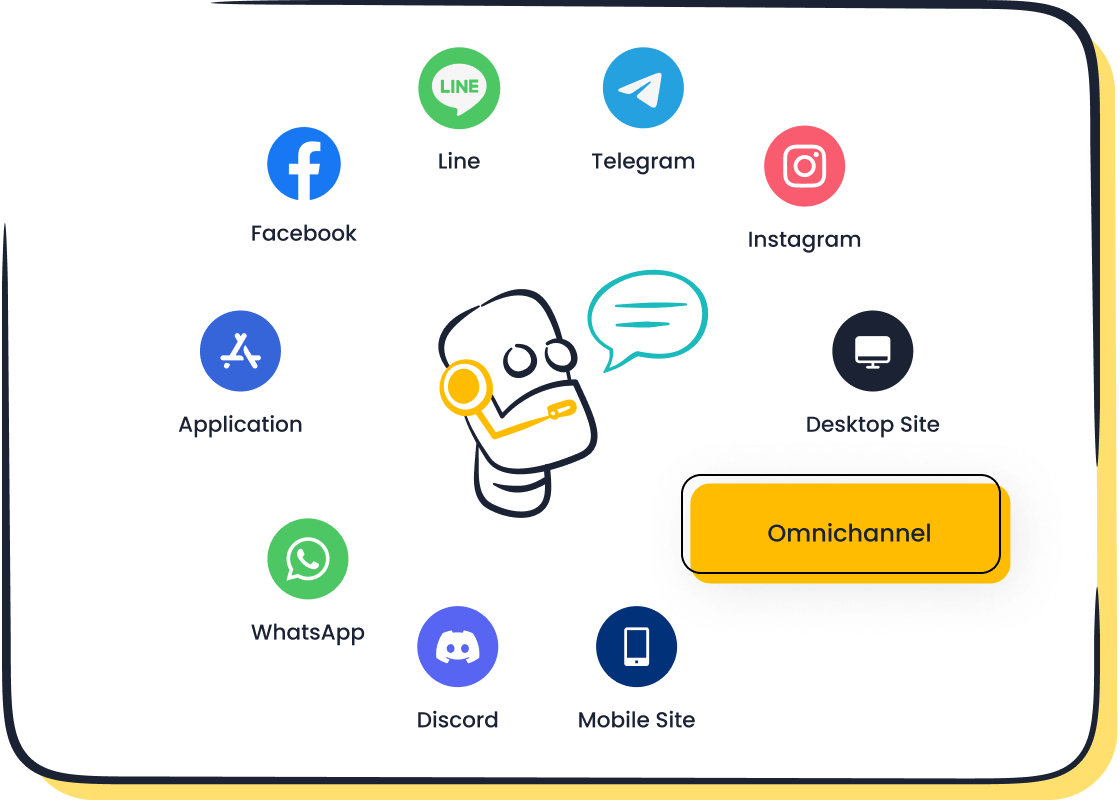
Sobot's AI Chatbot is a game-changer in automated customer engagement. It doesn’t just respond to your queries—it anticipates them. By analyzing your behavior and preferences, the chatbot delivers personalized recommendations and reminders.
For example, if you frequently shop online, the chatbot can notify you about upcoming sales or restocked items you’ve shown interest in. Its ability to operate 24/7 ensures you receive support whenever you need it. Businesses using Sobot’s Chatbot have seen significant improvements, including a 15-35% increase in response rates and an 80% reduction in knowledge base maintenance workload.
This AI-driven engagement tool also integrates seamlessly across channels, ensuring consistent experiences whether you’re interacting via chat, email, or social media. By leveraging Sobot’s Chatbot, businesses can proactively meet your needs, enhancing satisfaction and loyalty.
Examples of businesses excelling in proactive engagement
Several companies have already mastered proactive engagement, setting benchmarks for others to follow.
- Tesla uses predictive analytics to schedule vehicle maintenance before issues arise. This approach has reduced service problems by 20% and increased customer loyalty by 30%.
- Starbucks optimizes its mobile app to offer seamless ordering and rewards, boosting mobile engagement by 20% and sales by 15%.
- LEGO fosters engagement through its online community platform, achieving a 21% increase in customer interactions and an 18% reduction in acquisition costs.
These examples highlight how proactive strategies can transform your experience. By anticipating your needs and addressing them proactively, businesses not only improve satisfaction but also strengthen their relationships with you.
How proactive strategies drive customer loyalty and satisfaction
Proactive strategies transform your experience by anticipating your needs and addressing them before you even ask. This approach builds trust and strengthens your connection with a brand. When businesses act ahead of time, they show they value your time and preferences, which fosters customer loyalty.
Metrics reveal how proactive engagement correlates with increased satisfaction and loyalty. For example, Customer Satisfaction (CSAT) measures how happy you are with the service, while Net Promoter Score (NPS) indicates how likely you are to recommend the brand. First Contact Resolution (FCR) ensures your issues are resolved quickly, enhancing your experience. The table below summarizes these metrics:
| Metric | Description |
|---|---|
| Customer Satisfaction (CSAT) | Measures how satisfied customers are with your service |
| Net Promoter Score (NPS) | Indicates customer loyalty and advocacy |
| Customer Lifetime Value (CLTV) | Quantifies the revenue generated by a customer over their relationship with your business |
| Churn Rate | Measures the percentage of customers who stop doing business with you |
| Average Handle Time (AHT) | Tracks the average time spent on customer interactions |
| First Contact Resolution (FCR) | Measures the percentage of customer issues resolved on the first contact |
Sobot’s AI Chatbot exemplifies proactive engagement. It analyzes your behavior to predict your needs, offering personalized recommendations and reminders. For instance, if you browse products online, the chatbot can notify you about restocked items or upcoming sales. This proactive approach not only enhances your experience but also reduces churn rates and boosts customer satisfaction.
Real-world examples highlight the impact of proactive strategies. Businesses like Samsung have achieved remarkable results by anticipating customer needs. With Sobot’s unified contact center solution, Samsung improved agent efficiency by 30% and achieved a 97% satisfaction rate. These outcomes demonstrate how proactive engagement drives loyalty and ensures you feel valued.
By 2025, proactive strategies will become essential for businesses aiming to deliver exceptional experiences. When companies anticipate your needs, they create seamless interactions that deepen your loyalty and satisfaction.
Data Unification: The Foundation of Personalized Customer Experience
Why data unification is critical for customer experience journeys
Data unification connects fragmented customer data across multiple channels into a single, cohesive view. This unified approach is essential for understanding customer journeys and delivering personalized experiences. When businesses consolidate customer data, they gain insights into preferences, behaviors, and needs, enabling them to tailor interactions effectively.
A study highlights the importance of data unification in personalization. It shows that using AI and machine learning to create a single customer view helps companies adapt to evolving consumer habits. For example, 73% of consumers expect personalized content before and after purchase, according to a Forrester report. Additionally, companies investing in personalization technology see higher revenue and ROI, as noted by Adobe.
| Source | Key Findings |
|---|---|
| Forrester Report | 73% of consumers and 87% of business customers expect personalized content. |
| Adobe Report | Companies investing in personalization technology see higher revenue. |
By unifying customer data, businesses can meet these expectations and deliver seamless experiences that foster loyalty.
Benefits of a single customer view for businesses
A single customer view offers significant advantages for businesses aiming to enhance customer experience. It allows companies to understand preferences, predict needs, and align services with expectations. This approach not only improves satisfaction but also drives measurable business benefits.
| Evidence | Implication |
|---|---|
| Companies can gain up to a 16% price premium | Tailored experiences maximize this premium. |
| Customers try additional services | Cross-selling opportunities increase with better understanding. |
| Meeting expectations leads to benefits | Comprehensive views align services with customer needs. |
| 82% of consumers desire human interaction | Contextual data improves employee-customer interactions. |
For example, businesses with superior experiences often see higher customer lifetime value and reduced churn rates. A unified view of customer data enables brands to deliver these experiences consistently.
Sobot's approach to overcoming data silos and integration challenges
Sobot addresses data silos with its all-in-one contact center solution. This platform integrates communication channels like chat, email, voice, and social media, ensuring seamless access to customer data. By connecting internal systems such as ERP and ticketing, Sobot provides agents with a complete view of customer histories.
Sobot’s AI-powered tools also enhance data unification. The AI Chatbot uses a knowledge base to deliver accurate responses, reducing repetitive interactions. Businesses leveraging Sobot’s solutions have reported improved operational efficiency and customer satisfaction. For instance, Samsung achieved a 97% satisfaction rate and a 30% boost in agent efficiency by unifying its channels with Sobot’s platform.
With Sobot, you can overcome integration challenges and create personalized experiences that drive loyalty and engagement. Learn more about Sobot’s solutions here.
Predictions for data-driven CX strategies in 2025
Data-driven strategies will redefine how businesses interact with you by 2025. Companies will rely on advanced analytics and unified platforms to deliver personalized experiences that meet your expectations. Here are some key predictions shaping the future of customer experience:
| Trend/Prediction | Description |
|---|---|
| Personalization | 76% of people are more likely to purchase from personalized services. |
| Customer Expectations | 71% of consumers expect personalized interactions. |
| Real-time Analytics | 60% of companies improve customer experience with real-time analytics. |
| Budget Allocation | Businesses are increasing their budget for data infrastructure by 25%. |
| Unified Data Platforms | By 2025, 90% of businesses will rely on unified data platforms. |
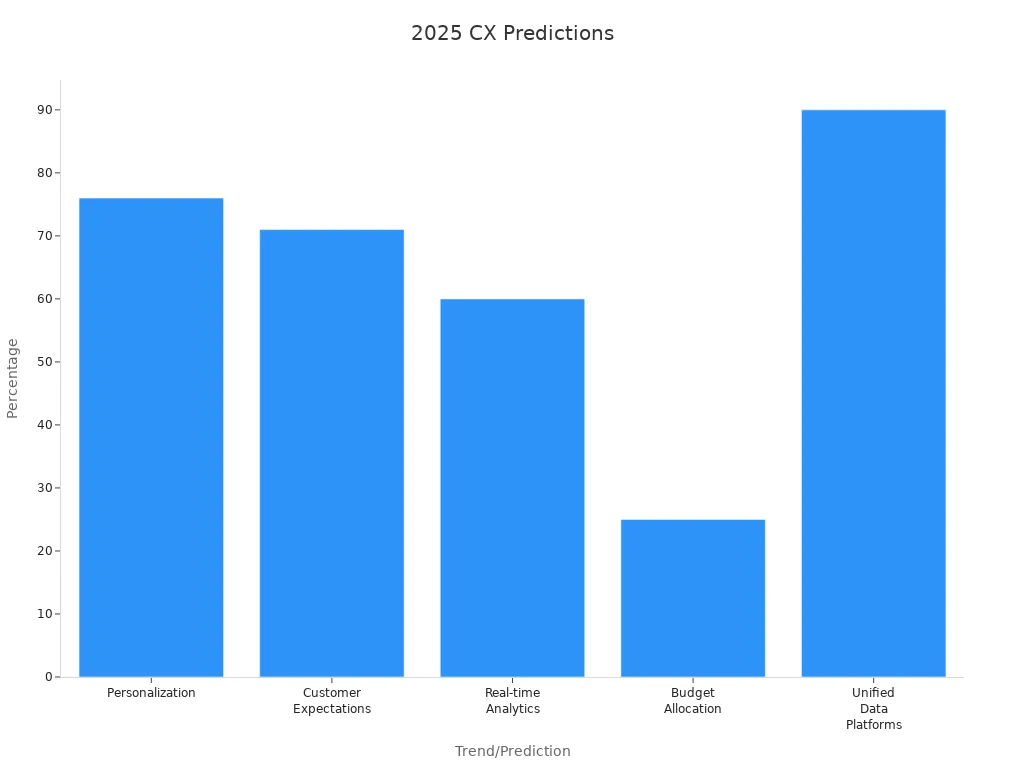
Personalization will take center stage. Businesses will use your data to tailor every interaction, making you feel valued. For example, 76% of people prefer personalized services, and companies using customer data for personalization see 40% more revenue. This trend highlights the growing importance of understanding your preferences.
Real-time analytics will also play a crucial role. Companies will analyze your behavior instantly to predict your needs and offer timely solutions. For instance, 60% of businesses already improve customer experience using real-time Voice of the Customer analytics. This approach ensures you receive relevant and efficient support.
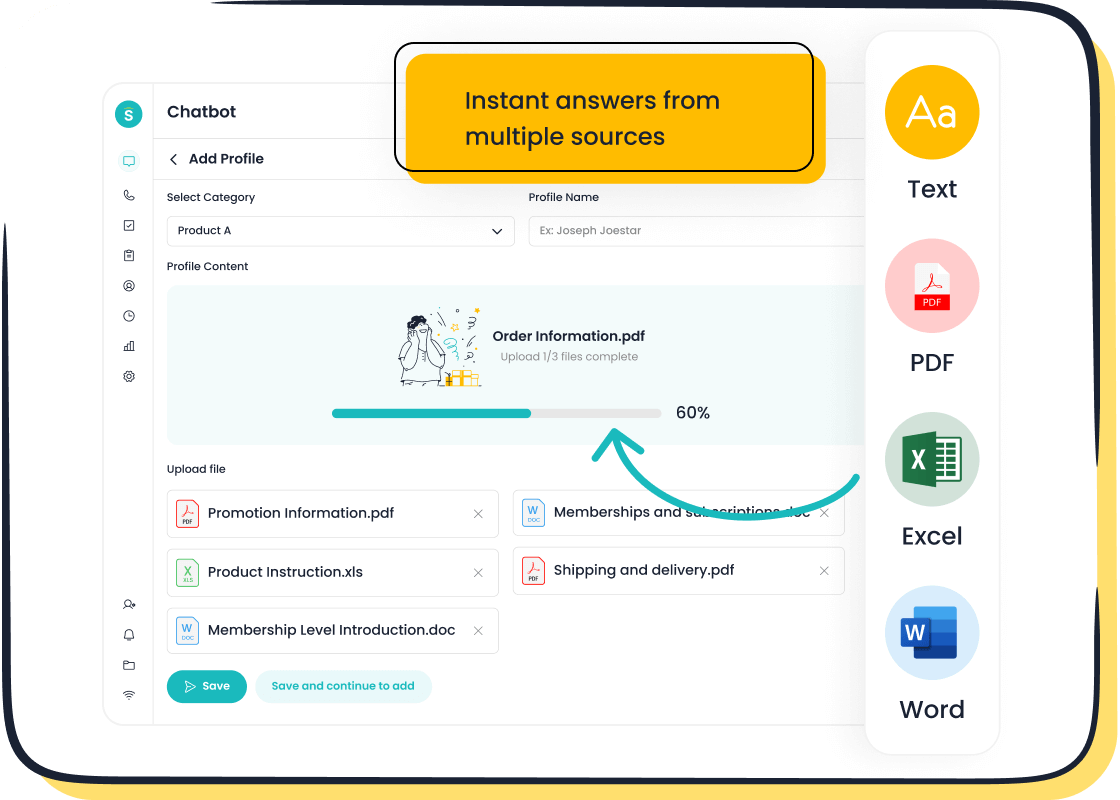
Unified data platforms will become essential. By 2025, 90% of businesses will adopt these platforms to consolidate customer data. Sobot’s all-in-one contact center solution exemplifies this trend. It integrates communication channels like chat, email, and social media, giving businesses a complete view of your journey. This unified approach enhances your experience by eliminating repetitive interactions and ensuring seamless support.
As businesses increase their budgets for data infrastructure by 25%, you can expect faster, smarter, and more personalized experiences. These advancements will not only meet your expectations but also set new standards for customer satisfaction.
Emotional Intelligence: The Human Touch in Digital Customer Experience
What is emotional intelligence in customer experience?
Emotional intelligence (EI) in customer experience refers to the ability to recognize, understand, and manage emotions during interactions. It plays a vital role in creating meaningful connections and ensuring satisfaction. Businesses with high EI can adapt to changing demands, empathize with customers, and manage emotions effectively.
Research highlights three key dimensions of EI that impact customer interactions:
| Dimension of EI | Description |
|---|---|
| Adaptability | Adjusting to evolving demands and performing well in diverse situations. |
| Empathy | Understanding customer emotions to enhance satisfaction. |
| Emotional self-management | Managing emotions to improve service outcomes. |
These dimensions ensure that every interaction feels personal and genuine, fostering trust and loyalty. For example, when a business empathizes with your frustration during a delayed delivery, it can turn a negative experience into a positive one by offering timely solutions.
How Sobot empowers businesses to build emotional connections
Sobot empowers businesses to create emotional connections by integrating advanced AI capabilities into its solutions. Unlike standard chatbots, Sobot’s AI agents engage in natural, context-aware dialogues. They provide instant responses, reducing frustration caused by long wait times. These agents also offer personalized product recommendations, much like a skilled sales representative.
- AI agents operate 24/7, ensuring you receive support whenever needed.
- They analyze your preferences to deliver tailored suggestions, enhancing your experience.
- Emotional intelligence drives conversions by understanding your needs and emotions.
For instance, if you browse a product online, Sobot’s AI can notify you about restocked items or related offers. This proactive approach not only improves satisfaction but also strengthens your connection with the brand.
The role of training and technology in fostering emotional intelligence
Training and technology play a crucial role in enhancing emotional intelligence in digital interactions. Studies show that 62% of customers feel emotionally connected to brands they frequently purchase from. Businesses that invest in EI training see improved Customer Satisfaction (CSAT) scores and First Call Resolution (FCR) rates.
Technology, such as AI and machine learning, further amplifies EI. Tools like sentiment analysis and personalized content recommendations help businesses understand your emotions and preferences. For example, Sobot’s AI Chatbot uses these technologies to analyze your behavior and provide emotionally resonant responses. This combination of training and technology ensures that every interaction feels thoughtful and personalized, fostering deeper engagement and loyalty.
Why emotional intelligence will be a key differentiator in 2025
Emotional intelligence will redefine how businesses meet customer expectations by 2025. It enables companies to connect with you on a deeper level, making every interaction feel personal and meaningful. As customer experience becomes the primary focus for businesses, emotional intelligence will emerge as a critical factor in standing out.
Several statistics highlight this shift. A survey of 1,920 business professionals revealed that customer experience is their top priority for the next five years, surpassing product and pricing. Companies earning $1 billion annually could gain an additional $700 million in revenue within three years by investing in customer experience. Furthermore, 86% of buyers are willing to pay more for exceptional service, with luxury services commanding a premium of up to 13%.
Emotional intelligence plays a pivotal role in shaping these experiences. It helps businesses understand and manage your emotions, ensuring interactions align with your expectations. For example, when a company empathizes with your frustration during a delayed delivery, it can turn a negative situation into a positive one by offering timely solutions. This approach builds trust and fosters loyalty.

Hyper-personalization, powered by emotional intelligence, will also transform customer interactions. Businesses will analyze your preferences and behaviors to deliver tailored recommendations and support. Sobot’s AI Chatbot exemplifies this trend. It uses advanced AI to engage in natural, context-aware conversations, ensuring you feel valued and understood. By integrating emotional intelligence into its solutions, Sobot helps businesses create experiences that exceed customer expectations.
As customer demands evolve, emotional intelligence will become a key differentiator. Companies that prioritize it will not only meet your needs but also build lasting relationships. This focus on emotional connections will set new standards for customer experience by 2025.
The trends shaping customer experience journeys in 2025 highlight the importance of personalization, omnichannel integration, proactive engagement, data unification, and emotional intelligence. These advancements redefine how businesses interact with you, ensuring every experience feels seamless and tailored. Metrics like NPS, CSAT, and CES demonstrate how these strategies improve customer loyalty, satisfaction, and operational efficiency.
To stay ahead, leveraging tools like Sobot's Chatbot is essential. It automates interactions, provides instant support, and personalizes experiences across channels. Businesses using AI-powered tools like Sobot see a 25% improvement in customer satisfaction rates and gain actionable insights from conversational data.
To enhance customer satisfaction and loyalty:
- Gather and analyze customer data to identify preferences.
- Segment customers based on behaviors.
- Deliver personalized experiences tailored to each segment.
- Continuously monitor feedback and refine strategies.
By adopting these steps, you can create meaningful connections and thrive in the evolving customer experience landscape.
FAQ
What is the role of AI in improving customer experience?
AI enhances customer experience by analyzing data to predict preferences and deliver personalized interactions. Tools like Sobot's AI Chatbot automate responses, resolve queries instantly, and operate 24/7. This improves satisfaction and efficiency, making every interaction seamless and tailored to your needs.
How does omnichannel integration benefit businesses?
Omnichannel integration connects all customer touchpoints into one system. It ensures consistency across platforms like chat, email, and social media. Sobot’s unified contact center solution simplifies this process, helping businesses deliver seamless experiences that increase customer loyalty and satisfaction.
Why is proactive engagement important for customer loyalty?
Proactive engagement anticipates your needs and addresses them before issues arise. For example, Sobot’s AI Chatbot sends reminders and personalized recommendations based on your behavior. This approach builds trust, reduces churn, and strengthens your connection with brands.
How does emotional intelligence impact customer interactions?
Emotional intelligence helps businesses understand and manage your emotions during interactions. Sobot’s AI tools use sentiment analysis to provide thoughtful responses, ensuring every experience feels personal. This fosters trust and loyalty, making you feel valued.
What are the benefits of unifying customer data?
Unifying customer data creates a single view of your preferences and behaviors. This enables businesses to deliver personalized experiences. Sobot’s solutions integrate communication channels and internal systems, ensuring agents access complete customer histories for efficient and tailored support.
See Also
Discovering Leading Cloud Contact Centers for 2025
Best Ten Customer Feedback Software Options for 2024
Evaluating Leading Contact Center Solutions for 2024
